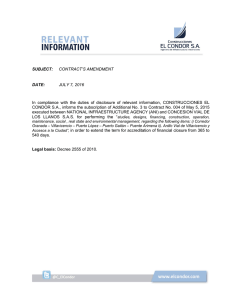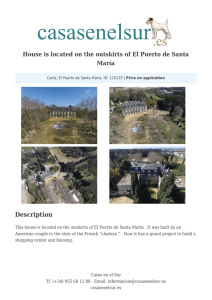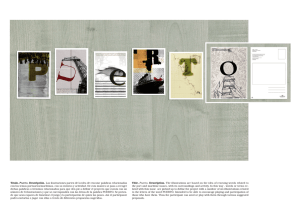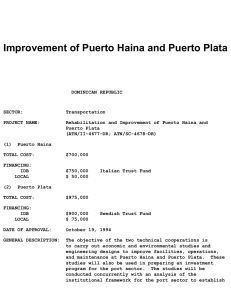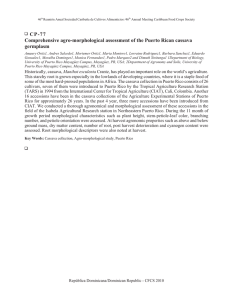complete paper - Cascadilla Proceedings Project
Anuncio
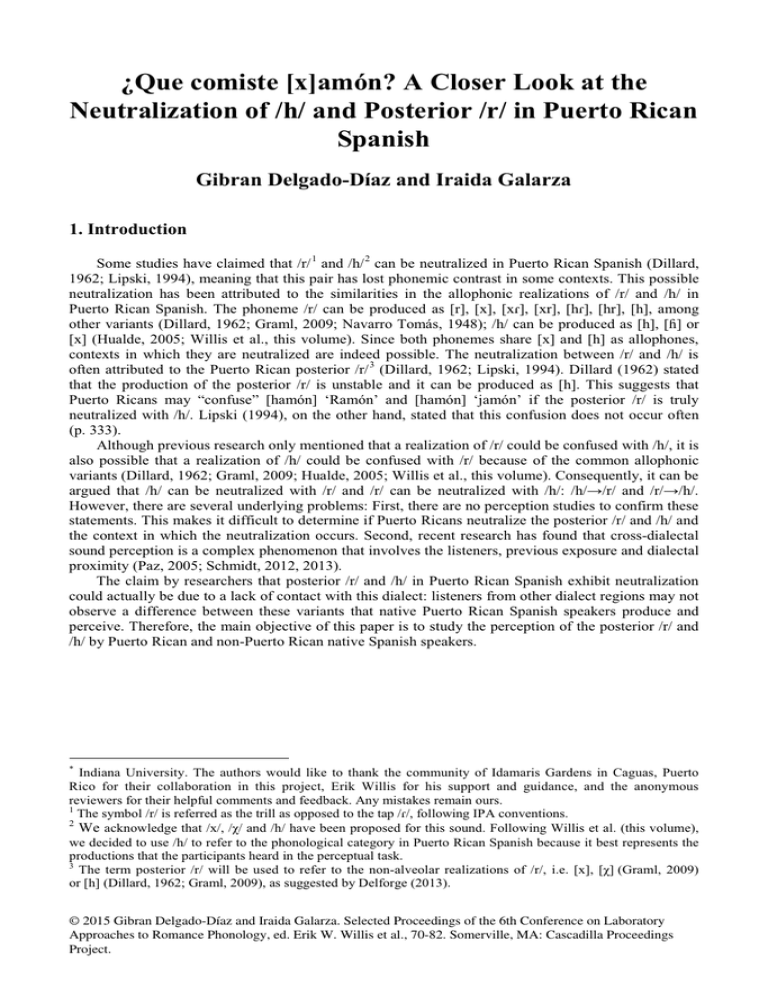
¿Que comiste [x]amón? A Closer Look at the Neutralization of /h/ and Posterior /r/ in Puerto Rican Spanish Gibran Delgado-Díaz and Iraida Galarza 1. Introduction Some studies have claimed that /r/ 1 and /h/ 2 can be neutralized in Puerto Rican Spanish (Dillard, 1962; Lipski, 1994), meaning that this pair has lost phonemic contrast in some contexts. This possible neutralization has been attributed to the similarities in the allophonic realizations of /r/ and /h/ in Puerto Rican Spanish. The phoneme /r/ can be produced as [r], [x], [x], [xr], [h], [hr], [h], among other variants (Dillard, 1962; Graml, 2009; Navarro Tomás, 1948); /h/ can be produced as [h], [] or [x] (Hualde, 2005; Willis et al., this volume). Since both phonemes share [x] and [h] as allophones, contexts in which they are neutralized are indeed possible. The neutralization between /r/ and /h/ is often attributed to the Puerto Rican posterior /r/ 3 (Dillard, 1962; Lipski, 1994). Dillard (1962) stated that the production of the posterior /r/ is unstable and it can be produced as [h]. This suggests that Puerto Ricans may “confuse” [hamón] ‘Ramón’ and [hamón] ‘jamón’ if the posterior /r/ is truly neutralized with /h/. Lipski (1994), on the other hand, stated that this confusion does not occur often (p. 333). Although previous research only mentioned that a realization of /r/ could be confused with /h/, it is also possible that a realization of /h/ could be confused with /r/ because of the common allophonic variants (Dillard, 1962; Graml, 2009; Hualde, 2005; Willis et al., this volume). Consequently, it can be argued that /h/ can be neutralized with /r/ and /r/ can be neutralized with /h/: /h /h/. However, there are several underlying problems: First, there are no perception studies to confirm these statements. This makes it difficult to determine if Puerto Ricans neutralize the posterior /r/ and /h/ and the context in which the neutralization occurs. Second, recent research has found that cross-dialectal sound perception is a complex phenomenon that involves the listeners, previous exposure and dialectal proximity (Paz, 2005; Schmidt, 2012, 2013). The claim by researchers that posterior /r/ and /h/ in Puerto Rican Spanish exhibit neutralization could actually be due to a lack of contact with this dialect: listeners from other dialect regions may not observe a difference between these variants that native Puerto Rican Spanish speakers produce and perceive. Therefore, the main objective of this paper is to study the perception of the posterior /r/ and /h/ by Puerto Rican and non-Puerto Rican native Spanish speakers. * Indiana University. The authors would like to thank the community of Idamaris Gardens in Caguas, Puerto Rico for their collaboration in this project, Erik Willis for his support and guidance, and the anonymous reviewers for their helpful comments and feedback. Any mistakes remain ours. 1 The symbol /r/ is referred as the trill as opposed to the tap //, following IPA conventions. 2 We acknowledge that /x/, // and /h/ have been proposed for this sound. Following Willis et al. (this volume), we decided to use /h/ to refer to the phonological category in Puerto Rican Spanish because it best represents the productions that the participants heard in the perceptual task. 3 The term posterior /r/ will be used to refer to the non-alveolar realizations of /r/, i.e. [x], (Graml, 2009) or [h] (Dillard, 1962; Graml, 2009), as suggested by Delforge (2013). © 2015 Gibran Delgado-Díaz and Iraida Galarza. Selected Proceedings of the 6th Conference on Laboratory Approaches to Romance Phonology, ed. Erik W. Willis et al., 70-82. Somerville, MA: Cascadilla Proceedings Project. 71 2. Previous research 2.1. The posterior /r/ in Puerto Rican Spanish The posterior /r/ was first studied by Navarro Tomás (1948) in the early 1920s and since then it has been the focus of many investigations. In his survey throughout the island, Navarro Tomás identified at least eight different articulations of the trill that he grouped into three types of productions: (i) velar productions (59%), (ii) alveolar productions (23%), and (iii) “mixed” variants (18%). The velar productions, which were the most numerous in his data, were described as voiced velar trills, and voiced/voiceless velar fricatives. The alveolar productions were either trills or voiced fricatives. Finally, the “mixed” variants, which he described as having two articulatory phases: an alveolar or velar frication followed by an alveolar trill or semi-trill, were either voiced mixed trills or voiced mixed fricatives. In terms of their geographical distribution, Navaro Tomás found that all of these productions were extended throughout the island, but he found the velar productions to be more dominant in the northwestern and southeastern part of the island. In summary, Navarro Tomás observed different productions of the posterior /r/, which he described as having a velar point of articulation and that differed with respect to their manner of articulation (rhotic, fricatives) and in terms of their voicing status (voiced, and voiceless). Another early study that aimed to describe the allophony of the trill is Dillard (1962). He identified two variants of the posterior /r/: a velar realization [x] and an aspiration [h]. He suggested that these realizations were susceptible to stylistic variation. Therefore, in what he identified as a “formal” or “careful” speech, Puerto Ricans would produce an alveolar trill [ adio ] 4 , whereas in a “normal” style they would produce a velar realization [xádio], and in what he defined as an “inferior” or “careless” style, they would produce a glottal variant [hádio]. In light of this allophonic distribution, the author suggested that Puerto Ricans can potentially confuse [xamõsíto] ‘Ramoncito’ with [hamõsíto] ‘jamoncito’ (small ham). However, it should be noted that this characterization of the posterior /r/ does not come from experimental data, but from anecdotal impressions. In addition, Dillard did not make any characterization of the role of voicing in this possible neutralization context. Graml (2009) conducted a large scale investigation regarding /r/ in Puerto Rican Spanish. 60 Puerto Rican speakers completed three oral tasks: a passage reading task, a word reading task and a sociolinguistic interview. The results show that 85% of the participants throughout the whole island used the posterior /r/ at least once during the data collection, which leaded Graml to suggest that the posterior /r/ is undergoing a diffusion process in Puerto Rico and can be found throughout the island. In addition, she made a phonetic analysis which included an auditory classification of the tokens followed by an acoustic analysis. Among her findings, she described 11 possible allophones of /r/ that varies with respect to manner and point of articulation: alveolar trill [r], alveolar tap [], post-alveolar approximant, post-alveolar fricative, pre-aspirated trill [hr], pre-aspirated tap [h], velar fricative [x], velar fricative followed by an alveolar trill [xr], velar fricative followed by an alveolar tap [x], glottal fricative [h], uvular trill []. Regarding the attitudes toward these variants, there seems to be a stigma associated with posterior articulations, which can be found in the early descriptions of the phenomenon. For example, Navarro Tomás (1948) commented “El uso de este sonido hablando español altera y deforma gravemente la pronunciación de este idioma” (The use of this sound when speaking Spanish seriously harms and deforms the pronunciation of this language) (p.124). More recently, many investigations have examined the attitudes that Puerto Rican speakers associate with the posterior realizations of /r/. The results of some of these studies suggest that Puerto Ricans attribute potentially negative characteristics, such as of rural origin, of low sociocultural level¸ and frenillo 5, to the posterior /r/ (Graml, 2009; López-Morales, 1979a, 1979b; Medina Rivera, 1997). The only positive attribute associated with this variant in these studies is that of typical of Puerto Rico (Graml, 2009; Medina-Rivera, 1997). However, Delforge (2013) noticed that these associations were not consistent across studies and argued that these discrepancies were due to the fact that many of these studies used multiple choice questionnaires and were in written form, which in turn did not allow for the participants to explain 4 We decided to use Dillard’s phonetic transcriptions to illustrate his examples. A speech impediment caused by a shortened lingual frenulum (Delforge, 2013) 5 72 their responses further. Moreover, she indicated that it may be the case that the many different realizations of the posterior /r/ are subject to different evaluations. To address these inconsistencies, she conducted a study which combined two different tasks: a matched-guise technique and an oral interview which directly addressed participants’ opinions with respect to the posterior /r/. She found that even though participants considered the posterior /r/ as a non-standard pronunciation, they frequently associated it with positive characteristics such as being educated and intelligent. Consequently, the use of the posterior /r/ does not prevent a speaker from sounding competent. To conclude, the studies reviewed above show that there are different realizations of the posterior /r/. In addition, Puerto Ricans are aware of these variants. Finally, different studies suggest that these posterior realizations may be associated with specific social characteristics, such as “of rural origins”. 2.2. Dialectal perception Recent studies have found that dialectal perception is a complex phenomenon. This body of research has revealed that the perception and categorization of sounds depends on the listeners own phonemic and allophonic inventory (Paz, 2005; Schmidt, 2013), dialectal contact (Schmidt, 2013) and geographical proximity (Schmidt, 2012). The first of these studies is Paz (2005) who examined the perception of the Puerto Rican approximant // in coda position. Unlike other Spanish varieties, syllable-final // is not produced with a tap realization but as a continuant sound. Among the possibilities there can be an intermediate sound between lateral and rhotic that is characterized as a rhotic approximant (Simonet et al., 2008: 73). She indicated that the difference between this approximant rhotic and the etymological lateral lied on the frequency of F3, which suggests an articulatory difference that may involve bunching of the tongue or retroflexion. In light of this acoustic difference, Paz wanted to test if this liquid contrast would be perceived by listeners of other dialects as well as Puerto Rican listeners. To this end, she conducted a perceptual study with 30 Puerto Ricans and 30 Argentineans listeners in which they had to identify words with an etymological lateral and an etymological rhotic produced as an approximant. She found that Puerto Rican listeners were more accurate in the identification of the word, with 81% of correct identifications, whereas Argentineans listeners performed at chance level with 48% of correct identifications. These results suggest that this liquid contrast is perceived by speakers of the dialect in which it is used and known. In turn, she questioned the real extension of the coda liquid neutralization in Puerto Rican Spanish, stating that it may not be as advanced as previously described, given the acoustic differences and the precision with which Puerto Ricans identify these sounds. Another study that sought to explore the perception of sociophonetic variants is Schmidt (2013). She investigated the identification of the aspiration of coda /s/ by listeners of La Rioja, Argentina, a weakening dialect, and listeners of Bogota, Colombia, a non-weakening dialect. Using a word identification task, she found that Argentineans tended to identify the aspiration as a realization of /s/, whereas Colombian listeners tended to map it to other sounds. These results supported those obtained by Paz (2005) in that listeners accurately perceive their own dialectal variants. However, Schmidt also explored the effect of dialectal contact in cross-dialectal perception and found that Colombian listeners that had contact with speakers of weakening dialects were significantly more accurate in the categorization of [h] as a realization of coda /s/ than the Colombians that did not have contact with speakers of these varieties. Consequently, this study provides evidence that, not only are listeners accurate in perceiving their own variants, but that exposure to other dialects has an effect on crossdialectal perception. Following this line of research, Schmidt (2012) examined the role of geographic proximity in the identification of the Rioplatense post-alveolar sibilant fricative [] in two yeista 6 dialects. The participants were 14 listeners from La Rioja, Argentina, which is geographically close to the Rioplatense area and 27 listeners from Bogota, Colombia, which is more distant to that region. Schmidt hypothesized that the greater the proximity to the Rioplatense zone, the greater the opportunity for exposure of their dialectal features. She found that the participants in her study frequently identified the nonce words containing the post-alveolar sibilant fricative [] with words with orthographic <ch>. This is expected in light of the studies reviewed above: listeners perceive their own 6 Schmidt indicates that yeista dialects have a palatal fricative [] for words such as calle [ka. e] and yema [e.ma]. 73 dialectal variants more accurately. However, she found an effect of geographical proximity in the identification of []: while listeners from La Rioja accepted both [] and [] as realizations of orthographic <y> and <ll>, listeners from Bogota tended to accept only []. This study emphasizes the role of geographic closeness and dialect contact in the perception of sociophonetic variants that are not part of a speaker’s own dialect. In summary, the studies discussed above show that listeners accurately perceive the sounds that are part of their own dialect and that there is an effect of dialect contact and geographical proximity in cross-dialectal perception. 3. Research questions In light of the previous research the following questions were formulated: 1. Are /h/ and the posterior /r/ perceptually neutralized in Puerto Rican Spanish? 2. What role does phonological context play in the perception of the posterior /r/ by Puerto Rican listeners? 3. If there is evidence of perceptual neutralization, in which direction does it occur (/h/ /h/)? 4. Do non-Puerto Rican native Spanish listeners perceive the posterior /r/ as an allophone of /r/? 4. Methodology 4.1. Participants A total of 17 listeners participated in this investigation. They were divided into two groups, Puerto Ricans and non-Puerto Ricans. The Puerto Rican group was composed of 10 participants (5 females and 5 males) living in Caguas, Puerto Rico, at the time of the experiment. This town is located in the east central area of the island, south of the capital, San Juan (figure 1). The age of the participants ranged from 21-65 years old. 7 The non-Puerto Rican group consisted of four Mexicans (3 females, 1 male) two Spaniards (1 female, 1 male) and 1 Bolivian female. The age range of this group was 21-29 years old. None of them reported having extensive contact with Puerto Rican Spanish. Figure 1: Map of Puerto Rico 7 Only one participant was 18 years old, the age range of the rest of the participants was 31-65. 74 4.2. Task In order to measure the perception of the posterior /r/ and /h/ a lexical identification task with pictures was created with PRAAT (Boersma & Weenink, 2014). In each trial the participants saw two pictures and heard a word; for example, they would hear the word baja [baa] and they would see a picture of a bar ‘barra’ /bara/ and a picture of a short woman ‘baja’ /baha/, then they would click on the picture that best represented the word they heard. The pictures and words consisted of minimal pairs between /r/ and /h/ (1) and distractors (2). The participants could hear the words up to two times per trial. (1) Ramón [ramon], [xamon] -jamón [hamon] resto [resto], [xesto]-gesto [hesto] barra [bara], [baxa]- baja [baa] barro [baro], [baxo]-bajo [bao] (2) - sana [sana]-gana [gana] baja [baa]-baga [baa] aro [ao]-ajo [ao] The stimuli were obtained by recording two native Puerto Rican speakers (1 female and 1 male). The standard pronunciation of /r/ (the alveolar trill) and the posterior /r/ 8 were recorded and used in the task. Figures 2 and 3 illustrate the production of the alveolar trill and the posterior realization of /r/. Figure 2: Example of the production of the trill /r/ in the word barra ‘bar’ 8 Even though several realizations of the posterior /r/ have been documented [x], [x], [xr], [h], [hr] (Graml, 2009) the stimuli for the posterior /r/ in the present study did not have any alveolar tap or trills and were all posterior fricatives. 75 Figure 3: Example of the production of the posterior /r/ in the word barra ‘bar’ Furthermore, the /h/ and posterior /r/ stimuli were analyzed with PRAAT for voicing (table 1). Voicing was determined by the pulses and the periodicity of the waveform. This analysis revealed that both /h/ and the posterior /r/ were produced voiceless in initial position. However, only one token of /h/ was produced voiceless in intervocalic position while the remaining ten tokens were voiced. Figures 4 and 5 represent the production of /h/ in post-pausal and intervocalic position. The posterior /r/ was always produced as voiceless independently of the position, contrary to what was indicated in previous studies. The reader is referred to Willis et al. (this volume) for an acoustic study of /h/ in Puerto Rican Spanish. Table 1: Distribution of the stimuli according to voicing and phonological context Post-pausal position Intervocalic position total /h/ Posterior /r/ voiced 0 0 voiceless 7 7 voiced 10 0 voiceless 1 11 18 18 76 Figure 4: Example of the production of /h/ in post-pausal position in the word jamón ‘ham’ Figure 5: Example of the production of /h/ in intervocalic position in the word baja ‘short’ 77 The experiment had a total of 81 trials; ten more trials were added to the Puerto Rican group and 13 were added to the non-Puerto Rican group as training. The training trials were designed so that the participants could ask questions and familiarize themselves with the vocabulary and the task. The nonPuerto Rican group had more training trials because dialectal words, such as ‘Morro’ (the Spanish fort in Old San Juan, Puerto Rico) and ‘morra’ (having a sleepy face), were used in the experiment. The training trials did not contain stimuli with the realization of the posterior /r/ to avoid any possible interference with the experiment. The trials that contained minimal pairs between /h/ and /r/, as in example (1), were analyzed. There was a total of 31 trials per participant. The responses were coded as target and non-target identifications. This decision was based on the intended phonological category in the Puerto Rican dialect; if the intended phoneme was /r/ and the listener chose /h/ it was coded as a non-target identification. In addition, if the intended phoneme was /h/ and the listeners chose /h/ it was coded as a target identification. For example, a response was coded as target if the stimulus was [hamón] /hamon/ and the listener selected the picture of a ham ‘jamón’. On the contrary, a response was coded as nontarget if the stimulus was [xamón] /ramon/ and the picture of a ham ‘jamón’ was selected. 5. Results The overall results show that Puerto Rican listeners were more accurate than non-Puerto Rican listeners. Puerto Ricans had a target rate of 73.3% while non-Puerto Ricans were on target 46.2% of the time (graph 1). A more detailed analysis was performed in order to identify where the differences between Puerto Ricans and non-Puerto Ricans lie. Graph 1: General results 80.0% 73.3% 70.0% 53.8% 60.0% 46.2% 50.0% 40.0% 30.0% Target Non target 26.7% 20.0% 10.0% 0.0% Puerto Ricans Non-Puerto Ricans The results were divided by listeners; Puerto Ricans were analyzed first. Graph 2 shows the perception between /h/ and the posterior /r/. The results indicate that Puerto Ricans had a target rate of 90.7% with /h/. The small percentage of non-target responses with /h/ (9.3%) might be due to the design of the task. Some participants double clicked the mouse providing a response to the next picture without hearing the word. Regarding the posterior /r/, graph 2 shows that Puerto Ricans were on target with 58.1% of the stimuli while non-target at a rate of 41.9%. Hence, it is necessary to examine the phonological context of the posterior /r/ in order to understand why Puerto Ricans showed this distribution. 78 Graph 2: Perception of /h/ and posterior /r/ by Puerto Rican listeners 100.0% 90.0% 80.0% 70.0% 60.0% 50.0% 40.0% 30.0% 20.0% 10.0% .0% 90.7% 58.1% 41.9% Target non target 9.3% /h/ posterior /r/ It seemed that the phonological context played a role in the responses. Puerto Rican listeners were more accurate in intervocalic context; they could accurately perceive the posterior /r/ as an allophone of /r/ in a rate of 70%. However, they were less accurate perceiving the posterior /r/ as an allophone of /r/ in initial position (38.3%). This suggests that Puerto Ricans have more difficulty distinguishing the posterior /r/ from /h/ in this context. Graph 3: Perception of the posterior /r/ by Puerto Rican listeners according to the phonological context 70.0% 61.7% 70.0% 60.0% 50.0% 30.0% 40.0% 38.3% Target Non target 30.0% 20.0% 10.0% .0% V_V _V A series of statistical analyses were performed in order to determine if the phonological context is a significant factor in the perception of the posterior /r/ and /h/ contrast. First, a Pearson chi-square test was performed to compare the percentages between intervocalic position and initial position. The result of the chi-square shows that there is a statistical difference between the percentages of ! !"2 (1) =15.45, p<.001). The participants had a target response rate of 70% in intervocalic position, whereas they only had a target response of 38.3% in initial position. This indicates that the target rate in both contexts is statistically different. In addition, to test if this distribution of target responses in intervocalic position was due to chance a binomial test was performed to compare the response percentage to 50% within each condition. In intervocalic position, 79 the 70% target rate was significantly greater than chance (p<.001); whereas in the word initial condition, the 38% target response rate was not significant (p=.93) compared to 50/50 chance. These results indicate that there is a positional neutralization of /h/ and posterior /r/: Puerto Rican listeners can significantly differentiate the posterior /r/ and /h/ in intervocalic position, whereas they perceptually neutralize both sounds in word initial position. However, in order to corroborate this finding it is necessary to incorporate more speakers and listeners with different social characteristics. This point will be further expanded in the discussion section. Regarding the non-Puerto Rican group, the results show a high target rate with /h/ independent of the phonological position (graph 4). A similar trend was found in Puerto Ricans who had a target rate of 90.7%. Graph 4: Perception of /h/ by non-Puerto Ricans listeners according to phonological context 100.0% 91.4% 90.0% 90.0% 80.0% 70.0% 60.0% Target 50.0% Non Target 40.0% 30.0% 10.0% 20.0% 8.6% 10.0% 0.0% V_V _V However, a categorical rate of non-target answers can be seen when examining the perception of the posterior /r/ by non-Puerto Rican listeners (graph 5). This means that the posterior /r/ is only perceived as /h/ by non-Puerto Ricans. These results may be explained by the fact that a posterior realization of /r/ has not been documented in any of the non-Puerto Rican dialects that were examined in the present study (Mexico, Spain and Bolivia) (Widdison, 1998). In addition, posterior /r/ may be closer to the phonetic realization of /h/ in Mexican and Peninsular dialects (Hualde, 2005). 80 Graph 5: Perception of the posterior /r/ by non-Puerto Ricans listeners according to phonological context 100.0% 98.6% 100.0% 90.0% 80.0% 70.0% 60.0% Target 50.0% Non Target 40.0% 30.0% 20.0% 10.0% 0.0% V_V _V 6. Discussion The first research question sought to examine if the posterior /r/ and /h/ are neutralized in Puerto Rican Spanish. The results indicate that /h/ and the posterior /r/ can be neutralized in this dialect; however, there was an effect of the phonological context. This leads to the second research question which inquired about the role of the phonological context. The results showed that the phonological context was a significant factor in the identification of the posterior /r/. Puerto Rican listeners had more problems identifying the posterior /r/ as an allophone of /r/ in initial position. However, they were significantly more accurate identifying the posterior /r/ in intervocalic position. Furthermore, the binomial analysis indicated that the responses for the intervocalic condition were not due to chance. We argue that this tendency may be constrained by voicing. Willis et al. (this volume) found that /h/ in intervocalic position was voiced at a high rate (90.4%) while it tends to be produced voiceless in initial position (86.5%) in Puerto Rican Spanish. This may indicate that Puerto Ricans rely on voicing to distinguish between /h/ and the posterior /r/. This would explain the low target rate in initial position. As mentioned above, the production of the stimuli in the present study followed this trend; /h/ was voiceless in onset position and voiced in intervocalic position. On the contrary, the posterior /r/ was always produced voiceless. This provides further evidence that Puerto Ricans listeners rely on voicing to distinguish /h/ and the posterior /r/. Although the results found in this study shows evidence that the posterior /r/ neutralizes with /h/ in initial position, some caveats need to be considered. First, previous research showed that the posterior /r/ has many phonetic variants (Dillard, 1962; Graml, 2009; Navarro-Tomás, 1948). This makes it difficult to identify an exemplar realization, if any. In addition, this could suggest that different realizations have different acoustic features that the listeners attend to. However, the present study did not control the precise point of articulation of the phonetic realization of the posterior /r/ because it is rather difficult to acoustically determine the exact place of articulation of posterior fricatives. This means that different posterior fricative variants [x] or [] were used in the experiment. Second, the results obtained in this investigation provide an insight of the possible neutralization context of /h/ and the posterior /r/. However, as mentioned in the results section, future studies need to incorporate Puerto Rican speakers and listeners with different social characteristics. We suggest that social factors may have an effect on perception, since Puerto Ricans tend to associate these variants to a specific social profile (older, rural men) (Graml, 2009; Delforge, 2013). In addition, there is evidence that social factors can influence speech perception (Drager, 2010). However, further research is needed to corroborate this hypothesis. 81 The third research question asked about the direction in which the neutralization occurs. According to previous research, it could be argued that the neutralization of the posterior /r/ and /h/ could occur from /h//h/ (Dillard, 1962; Graml, 2009; Hualde, 2005; Lipski, 1994; Willis et al., this volume). The present study found that the posterior /r/ can be neutralized with /h/. However, this trend was not found with /h/; Puerto Ricans had a higher rate of /h/ identifications, which means that /h/ is not perceived as the posterior /r/. The fourth question examined how non-Puerto Ricans perceived the posterior /r/. It was found that they do not perceive it as an allophone of /r/. This group mapped the posterior /r/ to /h/ in a categorical rate independent of the phonological context. These results confirmed those of Paz (2005) and Schmidt (2012, 2013) in that listeners are able to perceive their own dialectal variants. 7. Conclusions and Limitations The results obtained in this investigation support previous studies of dialectal perception in that listeners are more accurate in perceiving their own variants (Paz, 2005; Schmidt, 2012, 2013). Both Puerto Ricans and non-Puerto Ricans listeners had a high rate of accuracy with /h/, presumably because our listeners either use that variant or have knowledge of it. In addition, the present study found that Puerto Rican listeners accurately mapped the posterior /r/ in intervocalic position as a realization of /r/. In contrast, non-Puerto Rican listeners categorically mapped the posterior realization of /r/ both in intervocalic and post-pausal position to /h/. This clearly shows that they do not associate it with /r/ but instead with /h/. However, this study also found that in post-pausal position Puerto Ricans performed at chance level with respect to the identification of the posterior /r/. This suggests a contextual neutralization of /h/ and posterior /r/ in post-pausal position. We argue that this may be due to the allophonic distribution of /h/ and posterior /r/ in Puerto Rican Spanish and its relation with voicing: /h/ tends to be voiced in intervocalic position and voiceless in post-pausal position. This study shows that neutralization is not a simple phenomenon; it takes into account how the production and context affect the perception of the speakers. Following Schmidt (2012, 2013), future studies need to explore the effect of dialectal contact and geographical proximity in the cross-dialectal perception of posterior /r/. Furthermore, since many realizations of the posterior /r/ may differ in voicing, manner and point of articulation, future studies need to explore how these different variants affect the Puerto Rican Spanish phonological system. Specifically, future studies need to examine if some of these different phonetic realizations of posterior /r/ have different acoustic features that allow Puerto Ricans to distinguish them from /h/. Finally, future studies need to incorporate sociolinguistic factors into account in order to determine if they have an effect in the perception of the posterior /r/. Bibliography Boersma, Paul and David Weenink. 2014. Praat: doing phonetics by computer [Computer program]. Version 5.4.01, retrieved 9 November 2014 from http://www.praat.org/ Delforge, Ann Marie. 2013. Not Correct but Not Bad Either: Another Look at the Social Meaning of “Velar r” in Puerto Rican Spanish. In Selected Proceedings of the 6th Workshop on Spanish Sociolinguistics, eds. Ana M. Carvalho and Sara Beaudrie, 158-168. Somerville, MA: Cascadilla Proceedings Project. Dillard, Joey. 1962. Sobre algunos fonemas puertorriqueños. In Nueva Revista de Filología Hispánica, 16 (3).422-424. Drager, Katie. 2010. Sociophonetic variation in speech perception. Language and Linguistics Compass, 4(7).473480 Graml, Carolin. 2009. Puerto, RICO en variación: Variation socio-phonétique et son auto- et hétérosurveillance par les locuteurs – le cas de la vélarisation du /r/ en espagnol portoricain. Ph.D. dissertation. LudwigMaximilians-Universität, München. Holmquist, Jonathan C. 2003. Coffee Farmers, Social Integration and Five Phonological Features: Regional Socio-Dialectology in West-Central Puerto Rico. In Selected Proceedings of the First Workshop on Spanish Sociolinguistics, ed. Lotfi Sayahi, 70-76. Somerville, MA: Cascadilla Proceedings Project. Hualde, José I. 2005. The sounds of Spanish. Cambridge: Cambridge University Press. Lipski, John. 1994. Latin American Spanish. New York: Longman Publishing. 82 López-Morales, Humberto.1979a. Dialectos verticales en San Juan: Índices de conciencia lingüística. Dialectología y Sociolingüística: Temas puertorriqueños, ed. by Humberto López-Morales, 143-163. Madrid, Spain: Editorial Hispanova de Ediciones. López-Morales, Humberto. 1979b. Velarización de la /RR/ el español de Puerto Rico: Índices de actitudes y creencias. Dialectología y Sociolingüística: Temas puertorriqueños, ed. by Humberto López-Morales, 107130 Madrid, Spain: Hispanova de Ediciones. López-Morales, Humberto. 2003. A propósito de la sociolingüística aplicada: La /rr/ velar en el español de Puerto Rico. Español Actual: Revista de Español Vivo, 80.7-13. Medina-Rivera, Antonio. 1997. Variación fonológica y estilística en el español de Puerto Rico. (Unpublished doctoral dissertation). University of Southern California, Los Angeles. Medina-Rivera, Antonio. 2011. Variationist Approaches: External factors conditioning variation in Spanish phonology. In Manuel Díaz Campos (ed). The handbook of Hispanic Sociolinguistics, 36-53. Malden, MA: Wiley-Blackwell. Navarro Tomás, Tomás. 1948. El español de Puerto Rico: Contribución a la geografía lingüística Hispanoamericana. Editorial de la Universidad de Puerto Rico. Paz, Mercedes. 2005. Retroflection of post-nuclear /r/ in Puerto Rican Spanish. Paper presented at the 9th Hispanic Linguistics Symposium. University Park, PA: Pennsylvania State University, November. Schmidt, Lauren, B. 2012. Effects of dialect contact on the perception of sociophonetic variants: The Rioplatense assibilated palatal. Paper presented in the 6th Bi-annual Conference of Laboratory Approaches to Romance Phonology, Colegio de México, Mexico City. Schmidt, Lauren B. 2013. Regional Variation in the Perception of Sociophonetic Variants of Spanish /s/. In Selected Proceedings of the 6th Workshop on Spanish Sociolinguistics, ed. Ana M. Carvalho and Sara Beaudrie, 189-202. Somerville, MA: Cascadilla Proceedings Project. Widdison, Kirk. 1998. Phonetic motivation for variation in Spanish trills. Orbis, Bulletin international de documentation linguistique, XL, 51-61. Willis, Erik; Gibran Delgado-Díaz; and Iraida Galarza. 2015. Allophonic variation of the velar fricative /h/ in Puerto Rican Spanish. Selected Proceedings of the 6th Conference on Laboratory Approaches to Romance Phonology, eds. Erik W. Willis, Pedro Martín-Butragueño and Esther Herrera. Somerville, MA: Cascadilla Proceedings Project. Selected Proceedings of the 6th Conference on Laboratory Approaches to Romance Phonology edited by Erik W. Willis, Pedro Martín Butragueño, and Esther Herrera Zendejas Cascadilla Proceedings Project Somerville, MA 2015 Copyright information Selected Proceedings of the 6th Conference on Laboratory Approaches to Romance Phonology © 2015 Cascadilla Proceedings Project, Somerville, MA. All rights reserved ISBN 978-1-57473-467-6 library binding A copyright notice for each paper is located at the bottom of the first page of the paper. Reprints for course packs can be authorized by Cascadilla Proceedings Project. Ordering information Orders for the library binding edition are handled by Cascadilla Press. To place an order, go to www.lingref.com or contact: Cascadilla Press, P.O. Box 440355, Somerville, MA 02144, USA phone: 1-617-776-2370, fax: 1-617-776-2271, [email protected] Web access and citation information This entire proceedings can also be viewed on the web at www.lingref.com. Each paper has a unique document # which can be added to citations to facilitate access. The document # should not replace the full citation. This paper can be cited as: Delgado-Díaz, Gibran and Iraida Galarza. 2015. ¿Que comiste [x]amón? A Closer Look at the Neutralization of /h/ and Posterior /r/ in Puerto Rican Spanish. In Selected Proceedings of the 6th Conference on Laboratory Approaches to Romance Phonology, ed. Erik W. Willis et al., 70-82. Somerville, MA: Cascadilla Proceedings Project. www.lingref.com, document #3193.
